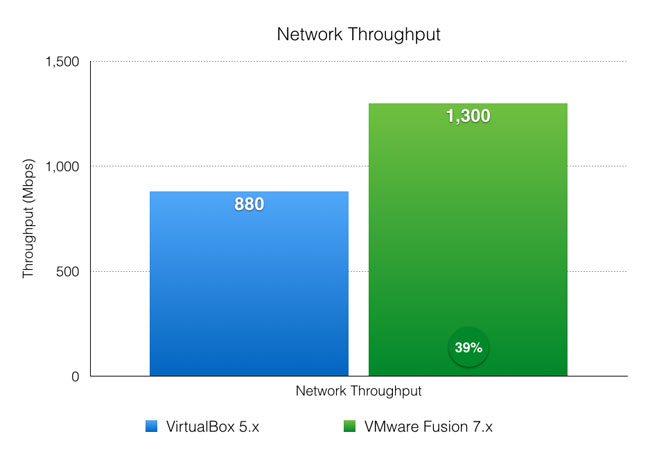
- #Vmware fusion 7 vs 8 speed for mac#
- #Vmware fusion 7 vs 8 speed mac os x#
- #Vmware fusion 7 vs 8 speed install#
- #Vmware fusion 7 vs 8 speed drivers#
- #Vmware fusion 7 vs 8 speed driver#
However, it provided a ballpark barometer for performance. Geekbench is not an ideal tool for benchmarking virtualization it gives a more accurate reflection on natively-run OSes.
Reviewers used Primate Labs’ Geekbench tool to do performance testing. There were system no crashes and less latency working within VMware’s VM.

Performance-wise, VMware Fusion fared a bit better than Parallels. In Unity mode, Windows applications are integrated within OS X. Unity is VMware Fusion’s answer to Coherence. Before creating a VM, the program gives the option of creating it as read only or write-only, a useful additional feature.
#Vmware fusion 7 vs 8 speed driver#
Guest OS is easy to setup, and while creating a Vista VM there were no problems with driver compatibility or network adapters. VMware Fusion 1.1.2 offers comparable features and functionality as Parallels Desktop. Deleting VMs can be done right from the Parallels menu which will evoke the utilitarian-named: Delete Virtual Machine Assistant. Want to delete a no longer needed VM? It’s simple in Parallels. This is great way to seamlessly work quickly between Mac and Windows applications. Instead, the Vista Start menu becomes anchored as an item on the Dock. For example, when running a Vista VM in Coherence, a separate Window for Vista does not appear on the Mac desktop.
#Vmware fusion 7 vs 8 speed mac os x#
This allows the guest OS to integrate into the Mac OS X environment. With Parallels Desktop, a VM can run in Coherence mode. The Vista VM locked up a few times, with the following message: “An unexpected error code -600.” This crashing ceased after restarting the VM two times.
#Vmware fusion 7 vs 8 speed drivers#
The network adapter, sound and display drivers were detected and caused no issues. USB support was enabled to “connect to guest OS.” The USB keyboard and mouse worked fine in the VM, but a USB thumb drive went undetected in the VM, and was only detected in the host OS. Too bad that was not the case with USB support. Parallels offers control options that are pretty granular: boot sequence, memory allocation and network adapter emulation options are among the configurable features for the virtual machine.ĭragging and dropping between the host OS and guest caused no problems.
#Vmware fusion 7 vs 8 speed install#
Setting up a Vista virtual machine from loading the CD to the last reboot after the install of Parallels Tools took 37 minutes.
#Vmware fusion 7 vs 8 speed for mac#
Parallels Desktop 3.0 for Mac was cake to install. VMware and Parallels are of course virtualization solutions while Boot Camp allows for dual-booting.Īll three programs were loaded on a spanking new Mac mini, outfitted with Leopard 10.5.2, a 1.83 GHs Intel Core 2 Duo processor and 1 GB RAM. I asking about normal daily work usage such as email, word processors, text editors, programmers’ IDEs ( IntelliJ, NetBeans), OmniGroup apps, LibreOffice, Apple Keynote/Pages/Numbers.These solutions achieve the same end: getting multiple OSes to run on a single platform but by different means. I'm not talking about gaming or running CAD/CAM systems. Apparently that emulation in provided in Mountain Lion as well, but not Yosemite.Ĭan anyone verify if Fusion by VMware (standard edition?, Pro edition?), or VirtualBox by Oracle, or any other solution can run Yosemite well as a guest OS on a host Mac including peppy graphics? Documenting their support for graphics acceleration would be ideal. Apparently the difference is due to a "software emulation of 2D/3D acceleration officially supported by Apple" (per the tech note linked above). Really! I set the Dock to the opposite side of the screen to remind myself that I'm using a VM. In contrast, Mountain Lion performs so well in Parallels 9 and 10 that I forget I am using a virtual machine. Generally it feels sluggishly delayed similar to screen-sharing over a very slow DSL internet connection. Windows in the Finder jump an inch or two at a time while dragging to move them. The Dock magnification appears chunky and delayed as you move the mouse across app icons.


Highlighting menu items cannot keep up with the mouse movement. This means Yosemite inside Parallels runs noticeably slowly in its screen rendering. I am disappointed to learn that the Parallels 10 (and earlier) does not support hardware accelerated 2D (nor 3D) graphics when Mac OS X is the guest OS.


 0 kommentar(er)
0 kommentar(er)
